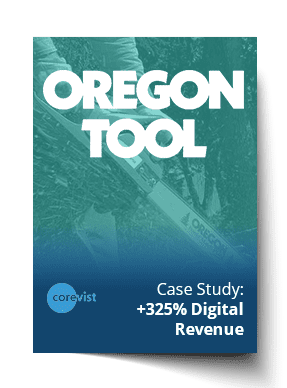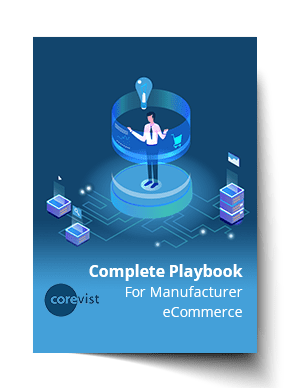Share
Author
George Anderson
Share
B2B eCommerce strategies are as unique as the companies pursuing them. But what strategies and tactics are working in today’s fast-changing digital environment?
There are definitely winners and losers in B2B eCommerce. In this article, we’ll give you five brilliant strategies that our clients are using to succeed.
Before we get to the strategies, we need to define some terms.
B2B eCommerce strategies vs. tactics
Before we go any further, we need to clarify one thing. B2B eCommerce strategies are not the same thing as tactics. A strategy is a conceptual plan for how you’ll get to a goal — e.g., “We’ll grow revenue by reaching X specific new market with Y value prop.”
Tactics are concrete projects, actions and programs that you use to execute that strategy. For the imaginary example above, you might define certain tactics like these.
- Launch B2B eCommerce for X market
- Optimize the B2B eCommerce site for organic SEO to attract traffic with a low cost of acquisition
- Run an iterative program tracking which products are frequently bought together, then set up promotional campaigns to push those related products
In this article, we’ll give you some powerful B2B eCommerce strategies that we’ve seen among our clients. Though this isn’t an article on tactics, we’ll also give you a list of tactics that could support each strategy to get you started on execution.
Note that you can combine these B2B strategies, too. They’re not mutually exclusive.
All right, let’s dive in!
B2B Strategy 1: Ease into digital customer experience with a post-order care portal
For some organizations, B2B eCommerce is a tough proposition. If you’ve got phone, fax and email ordering firmly embedded into your business processes, how can you help customers make the transition to digital?
It’s an important question, because phone, fax and email order entry costs far more than self-service B2B eCommerce.
Of course, customer habits aren’t the only thing that can add friction to a B2B eCommerce program. Internal issues can also slow you down. Maybe your product content isn’t ready — you don’t have your product images and documentation together. Maybe your SAP ERP business rules need cleaning up before you bring them to the web through integrated B2B eCommerce.
Whatever the reason, many organizations need a B2B eCommerce strategy that starts with small steps (while still dreaming big). This is why many companies start with a post-order portal for customers. With real-time SAP data for order status and history, shipment status and invoice status and history, a portal like this provides obvious value to customers (which helps acclimate them to digital business processes).
It also leverages your existing SAP ERP data without a lot of work required on your end, which makes it a great first step from an internal perspective, too.
The key is to choose a solution that allows you to expand to full-featured B2B eCommerce on the same SAP integration architecture. (Hint: That’s the Corevist Commerce model.)
Tactics
- Engage a partner with a project methodology that incorporates customer feedback from the very beginning.
- Engage customer service reps from the start to identify which routine tasks eat up the most of their time. (These are the tasks that you want to transition to customer self-service in the portal.)
- Identify customer portal platforms that include SAP integration and can expand to full-featured B2B eCommerce on the same architecture.
- Engage customer service reps to help customers transition to using the portal. Your reps are the best ones to do this, since they work with customers every day.
- Define your roadmap for rolling out B2B eCommerce. Which sales areas, product lines or customer segments will get B2B eCommerce first? Which segments will follow them? While the B2B portal is rolling out, you can start getting product content and SAP ERP business rules in order so the B2B eCommerce rollout goes smoothly.
B2B Strategy 2: Roll out globally with a platform that supports integrated spinoff sites
If you have multiple sales areas, brands, product lines or customer segments, it’s challenging to define a workable B2B eCommerce strategy. How do you meet the needs of each segment without reinventing the wheel as far as technology and architecture?
This question is especially important when it comes to SAP integration. If you’re forced to build a custom integration for every brand or geography, you’re wasting resources — particularly if those lines of business reside in the same SAP system. Even if you have separate SAP ERP systems for each segment, you shouldn’t have to rebuild your integration if those SAP systems are templatized.
In fact, a platform with a reusable SAP integration architecture is the key to an efficient global rollout. When you can reuse the architecture of your flagship site to launch spinoff sites (using the same SAP integration), you can bring additional segments online fast — with their own look and feel.
Tactics
- Identify B2B eCommerce platforms that meet your SAP integration needs.
- Identify your “template” segment — the brand, geography or line of business that offers the most reusability in terms of business processes and logic.
- Define the order of your B2B eCommerce rollouts, starting with your template segment.
- Engage a trusted advisor with a project methodology that incorporates customer feedback on live, working software for each rollout. It’s essential to get this iterative feedback as you move through the global rollout.
Case Study:
Lean, mean, global B2B eCommerce rollout
Learn how Oregon Tool launched Corevist Commerce in numerous geographies with reusable SAP integration architecture. The best part? 325% revenue growth.
B2B Strategy 3: Launch a new product or product line with B2B eCommerce
Let’s say you’ve got an innovative new product (or product line) that’s going to disrupt your market.
Let’s say you don’t currently have a B2B eCommerce program in place — or you do, but customers aren’t using the webstore (which usually happens if you don’t have real-time SAP integration).
Now imagine launching your new product through your new B2B eCommerce experience.
This is a brilliant strategy, and we’ve seen it work well for manufacturers. A revolutionary product in a revolutionary B2B eCommerce experience creates a powerful impact on the market. B2B eCommerce allows you to show off your new product in the best possible light. It also acts as a great digital destination for all your marketing efforts — the “system of record,” if you will, for the product’s public image.
Tactics
- Identify the B2B eCommerce experiences that are available for competing products. What’s great about these experiences? What’s not? Incorporate your findings into the requirements for your B2B eCommerce solution.
- Define your B2B marketplace strategy (if any). Are you going to sell the new product on Amazon B2B or similar marketplaces? If so, how will you protect your brand reputation from third-party knockoffs?
- Define your joint marketing strategy with your channel partners (if any). How can your existing dealers or distributors help make this product launch a success? What’s in it for them?
B2B Strategy 4: Move existing customers to B2B eCommerce by incentivizing sales reps to act as evangelists
Like B2B eCommerce strategy #1, this one is great for creating a soft transition to B2B eCommerce for existing customers. The idea is to involve your sales reps in the project from the start (and design the B2B eCommerce program so it creates value for them, rather than threatening them).
You can onboard your sales reps and have them use B2B eCommerce as a portal for order entry and customer care. When sales reps see how easy the platform is to use, they’re in a great place to communicate the value to customers.
This is a powerful strategy if you need to launch B2B eCommerce to increase efficiency, but your customers are used to phone, fax and email ordering.
Tactics
- Involve sales reps from the beginning of the project so they don’t feel threatened by B2B eCommerce.
- Identify B2B eCommerce platforms that include SAP integration (so sales reps can place orders on behalf of customers, with accounts mapped from SAP).
- Run a pilot program in which only sales reps use B2B eCommerce so they learn the value it offers customers.
- Create an incentive program so sales reps can get a fair commission for orders that customers place through B2B eCommerce.
- Create a program to manage sales reps as they onboard customers to B2B eCommerce.
Webinar:
Getting Sales On Board With B2B eCommerce
Learn how Bioventus rolled out B2B eCommerce first to sales reps, then to customers, with great success.
B2B Strategy 5: Increase market share by selling directly to the end user
Historically, manufacturers haven’t been equipped to sell directly to their end customers (whether those customers are businesses or consumers). Manufacturers make products in large quantities to leverage economies of scale — but customers need smaller quantities. These smaller quantities create all kinds of challenges in logistics, order fulfillment and shipping.
Hence the existence of distributors.
And while distributors bring great value to manufacturers in terms of fulfillment, their interests aren’t aligned 100%. For example, if a distributor is out of stock on a manufacturer’s product, the distributor’s B2B eCommerce site will suggest a competing SKU from a different supplier.
The distributor still gets the sale, which is their primary goal. But the manufacturer loses out on the opportunity to sell a similar product of their own.
What’s more, the manufacturer loses out on visibility into demand. That’s unfortunate, because B2B eCommerce analytics offer incredible opportunities to track and analyze shifts in product demand.
You can track similar patterns with distributors buying on your B2B eCommerce site, but it’s not the same as direct demand. When you’ve got end consumers buying from your B2B eCommerce store, your data on product demand is far more accurate (and granular).
Of course, selling direct has all kinds of implications for your existing relationships with dealers and distributors. If you go direct, you’ll probably lose those relationships. Whether the gain of selling direct outweighs the cost will depend on your specific market and circumstances.
Tactics
- Analyze the value of your existing distribution relationships. What sales are they bringing you, and what sales are they making on your products?
- Analyze the market reach of your distributors. Do you have relationships with these potential customers, or do they represent a brand-new market segment?
- Conduct a cost/benefit analysis of the marketing programs you’ll need to reach end users. At what point do you start breaking even? Where will profits be in three years — or five?
- Run surveys and, if you can, focus groups with your potential direct customers. What do they care about? What needs will you have to meet to get the sale not once, but over and over?
NEW Guide:
Your Complete Playbook for Manufacturer eCommerce
Here are 4 keys to a successful eCommerce channel for manufacturers.












